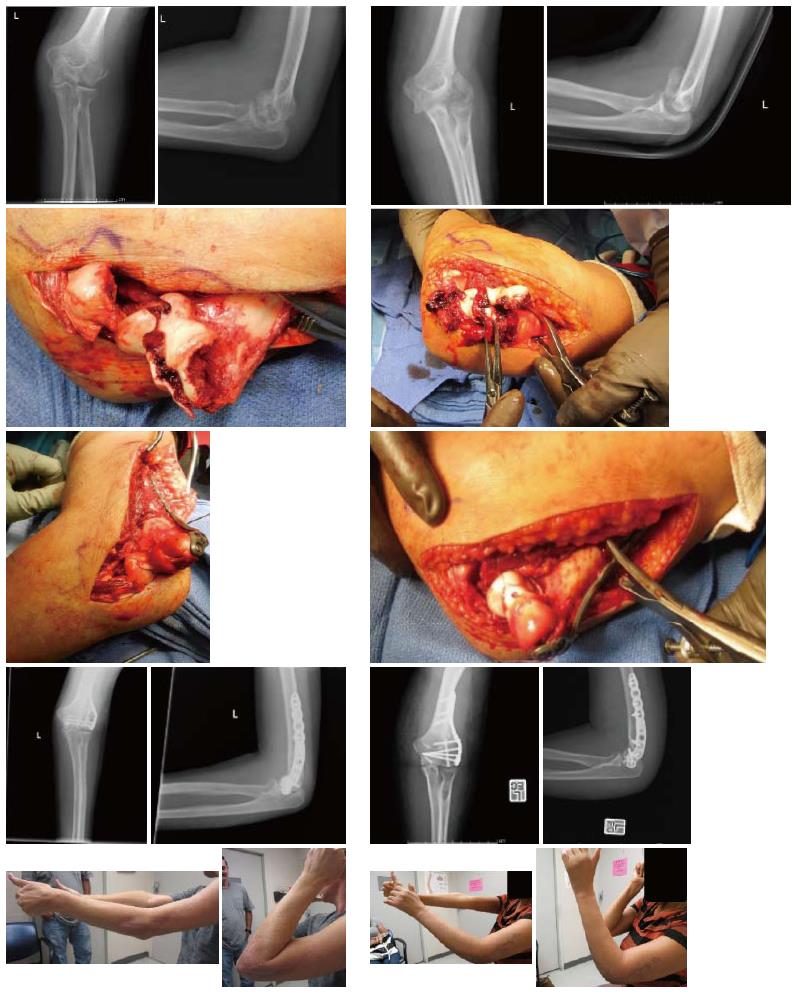Copyright
©The Author(s) 2015.
World J Clin Cases. May 16, 2015; 3(5): 405-417
Published online May 16, 2015. doi: 10.12998/wjcc.v3.i5.405
Published online May 16, 2015. doi: 10.12998/wjcc.v3.i5.405
Figure 1 Lateral elbow X-ray of a two patients with distal humeral coronal shear fractures.
A: Distal humeral coronal shear fracture - lateral view; B: The double-arc sign is seen, which signifies a McKee’s type IV fracture in the Bryan and Morrey classification (involvement of both the capitellum and trochlea).
Figure 2 Headless compression screws.
A: Holes left by headless screws in the articular surface. This patient later returned to surgery for a contracture release; B: At that time screw holes are shown to be covered with fibrocartilage.
Figure 3 Total elbow arthroplasty.
A-E: A non-reconstructible coronal shear fracture in an elderly patient. A total elbow arthroplasty was performed in this patient; F-H: Postoperative range of motion.
Figure 4 Comparison of outcomes following lateral extensile approach open reduction and internal fixation.
Pictures in the left column represent a 52 years old female who fell from a 2 feet wall. Pictures in the right column represent a 45 years old female who fell from a standing height. As can be seen in the first two rows of pictures in each column, both these patients sustained similar Dubberley type 3b fractures. The third and fourth rows in each column shows that good reduction and fixation was achieved intra-operatively in both patients. The last row in each column show maximum range of motion in each patient. The patient in the left column achieved a reasonable outcome, while the patient in the right column had severe stiffness and range of motion deficit which required an operative contracture release. Both patients underwent open reduction and internal fixation of their fractures using the lateral extensile approach for which the lateral collateral ligament was divided. Secondary to poor results, we have abandoned this method and now universally use the technique shown in Figure 4 or utilize olecranon osteotomy.
Figure 5 Two-incision approach.
A case demonstrating the two incision approach (lateral and medial). A: The lateral collateral ligament is not reflected (the plate is placed directly on top of it). Stable fixation of the capitellar fragment could not be obtained with headless compression screws and a one-third tubular plate was added for stability; B: Flexion demonstrates a mild amount of impingement, which was not symptomatic postoperatively; C: Anterior view demonstrates trochlear fracture line. Even though two incisions are used there is less soft tissue dissection overall than required in other approaches; D-G: Approximate 6 wk follow-up range of motion in this patient.
- Citation: Yari SS, Bowers NL, Craig MA, Reichel LM. Management of distal humeral coronal shear fractures. World J Clin Cases 2015; 3(5): 405-417
- URL: https://www.wjgnet.com/2307-8960/full/v3/i5/405.htm
- DOI: https://dx.doi.org/10.12998/wjcc.v3.i5.405













